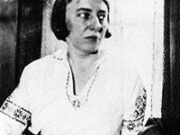The radical novels that Grace Lumpkin wrote in the 1930s, To Make My Bread and A Sign for Cain, represent two of the best examples of literary social realism produced in response to the economic and social turmoil of the Great Depression. Lumpkin used the Loray Mill strike, which took place in Gastonia, North Carolina, in 1929, and the Scottsboro case, which erupted in Alabama in 1931, as the historical and social backdrops for her novels. She proudly answered the call made in 1929 by Mike Gold, a prominent literary critic with ties to the Communist Party, for socially conscious young writers to “go left.” Like other writers of her generation, Lumpkin was convinced that a new, revolutionary form of writing could not only record the hardships and heroic struggles of the American working class but also mark a welcome return of social consciousness to American literature.
Born in Milledgeville on March 3, 1891, Lumpkin later moved with her family (including her younger sister, Katharine Du Pre Lumpkin, who grew up to become a well-known sociologist) to South Carolina, where she witnessed firsthand the suffering of Black and white sharecroppers and laborers. She returned briefly to Georgia, where she trained to be a teacher at Brenau College (later Brenau University) in Gainesville and eventually organized an adult night school for farmers and their wives. During most summers she lived in the mountains of North Carolina, staying with mill workers, sharecroppers, and other laborers, and as she would describe it later, she became “convinced… that the workers could better their lives only by means of unions.” Her stay in the mountains introduced her to the families that she wrote about in her first novel.
In the mid-1920s Lumpkin moved to New York City, where she enrolled in evening courses in creative writing and journalism at Columbia University. She also became fully immersed in the radical culture around her, attending demonstrations, joining picket lines, speaking at conferences and meetings, and generally supporting pacifist, socialist, and radical causes. After witnessing the brutal tactics used against workers in the recurrently violent textile strike in Passaic, New Jersey, Lumpkin became involved with the Communist Party.
The publication of To Make My Bread in 1932 launched Lumpkin’s career as a writer and gave her prominence on the literary left. She counted among her many friends and acquaintances Sherwood Anderson, Whittaker Chambers, John Dos Passos, Josephine Herbst, Granville Hicks, Scott Nearing, Mary Heaton Vorse, and Edmund Wilson. First lady Eleanor Roosevelt was among those who attended a theatrical adaptation of To Make My Bread; her presence was a sign of the extent to which a radical agenda had made its way into the political mainstream of America. After the publication of A Sign for Cain in 1935 Lumpkin went on to publish two more novels, The Wedding (1939) and Full Circle (1962).
Lumpkin’s life and writing were dramatically influenced by cultural radicalism, with its links to U.S. communism in the 1930s, and the ferreting out of Communists and Communist sympathizers in the 1950s. Despite her ties to the Communist Party during the 1920s and 1930s, Lumpkin became aggressively reactionary twenty years later—during U.S. senator Joseph McCarthy’s witch hunts for former radicals Lumpkin gave the names of her radical acquaintances to a Senate subcommittee. Soon after her testimony she returned to the South, eventually moving to Columbia, South Carolina. Her later writing was devoted to exposing the evils of communism and exploring Communist-to-Christian conversion experiences. She died in Columbia in 1980.




